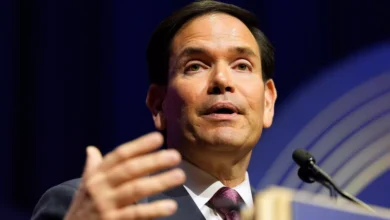Expelled from Aleppo as children, these fighters returned as its liberators

When Abdallah Abu Jarrah was 13, he dreamed of becoming an engineer or a lawyer.
But his home city of Aleppo was besieged by Syrian regime forces, aided by Iran, Russia and Hezbollah.
“The situation was terrible with bombings, beatings and killing,” the now 21-year-old told Al Jazeera. “I remember the regime’s massacres, the killing, and the hitting of bakeries and hospitals.”
Eight years later, a series of images went viral on social media. Youth, displaced by the regime in 2016, had returned as fighters to liberate the city of Aleppo. The side-by-side photos showed children boarding buses in one photo. In the next photo, they are young men smiling broadly, wearing military fatigues and carrying rifles.
On December 22, 2016, a four-year battle that pitted regime forces and their allies against the opposition ended with the evacuation of thousands of opposition forces from East Aleppo on buses.
War crimes were rife.
The UN reported in November 2016, a month before the end of the battle, that East Aleppo had no working hospitals.
“The brutality and the intensity of the fighting was not seen before,” Elia Ayoub, a writer and researcher who covered the fall of Aleppo, said.
The UN also criticised opposition groups for indiscriminate shelling of civilian areas “to terrorise the civilian population” and for shooting at civilians to try and keep them from leaving the areas.
At least 35,000 people were dead and much of the city destroyed by 2016 – most of it still in ruins eight years later. At least 18 percent of the dead were children.
Capital of the Syrian revolution
When a peaceful uprising demanding reforms broke out in Syria in 2011, al-Assad responded with brutal force. The opposition took up arms and challenged the regime around the country.
The regime relied on foreign intervention. Hezbollah and Iran joined the fight in 2013 and the Russian intervention in late 2015, ostensibly to counter ISIL (ISIS), pushed the opposition back.
“Symbolically, Aleppo was the capital of the revolution,” Ayoub said. “Its fall was preceded by other cities and it was this final nail in the uprising’s coffin at that time.”
The city would stay under regime control for almost eight years. Many who fled Aleppo moved to Idlib in Syria’s northwest and huddled in displacement camps, where they suffered years of air attacks by the regime and its allies.










